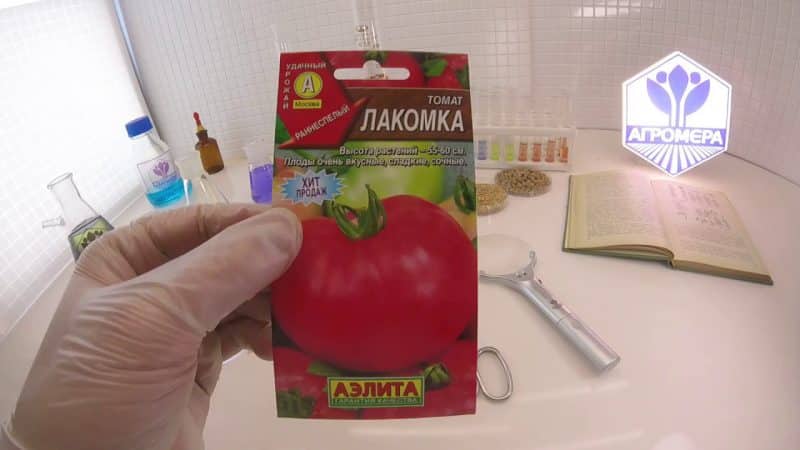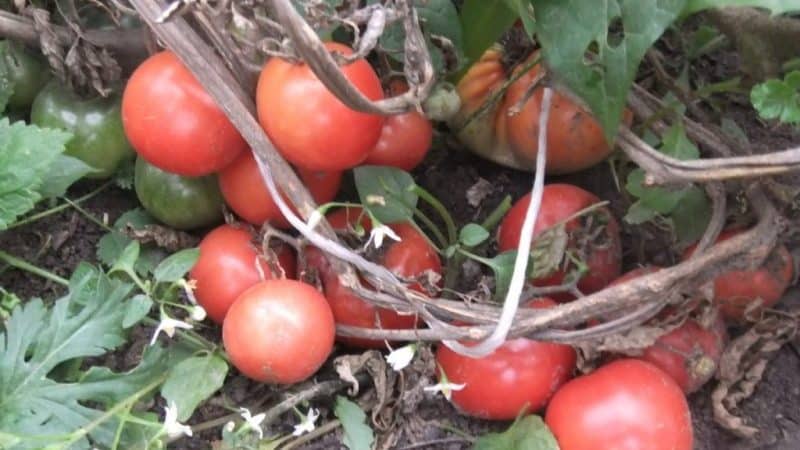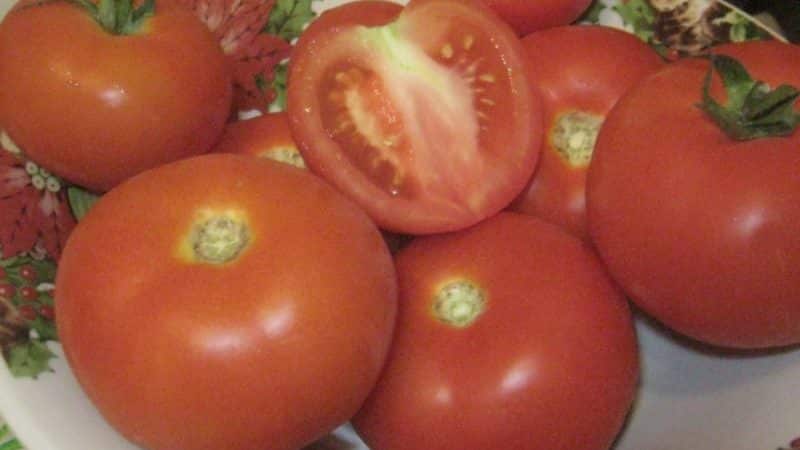Does the Lakomka tomato live up to its name and what do vegetable growers say about the variety?
The Lakomka tomato variety is an excellent choice for growing in a summer cottage according to several criteria. This is an early ripening variety - the harvest can be obtained within 90 days after sowing the seeds, which is very important in the Russian climate, when rains can begin to fall from the beginning of August. In addition, it is productive, disease-resistant, tasty and versatile in consumption - medium-sized fruits are convenient for canning.
In the article you will get acquainted with the characteristics and detailed description of the variety of this tomato.
Description of the variety
A gourmet is considered short tomato The height of the bush reaches 60 cm. The shape of the plant is semi-spreading, the number of leaves is small. In general, the bush is compact and does not require tying up.
During the growth process, several brushes are formed, the first is formed above the 8-9 leaf, the next ones - at intervals of 1-2 leaves. The fruits are raspberry-colored, round in shape, weighing about 130 g, and have a characteristic sweet tomato taste.
Interesting! There is a black-fruited version of Gourmet - the Black Gourmet tomato, but their similarity is limited only by the name. The dark representative of the nightshade family is tall and grows up to 2 m. The percentage of sugar in the Black Gourmet tomato is 2.5 times higher than the amount of organic acids.

Features, advantages and disadvantages of the variety
Tomato compares favorably with other varieties in a number of ways:
- fruit ripening is one-time;
- resistant to pathogens of fungal and bacterial diseases;
- resistant to adverse weather conditions and lack of water;
- due to the compactness of the bushes, it does not take up much space;
- there is no need to form a bush;
- Tomatoes tolerate transportation well, as they have durable skin.
No defects were noticed during the entire growing period.
Fruit characteristics and yield
Gourmand tomatoes are raspberry-colored, without a green spot around the stalk, round in shape, weighing about 120-130 g. The fruits have a juicy pulp of low density with a characteristic sweet tomato taste. Under the thin skin there are 3-4 nests for seeds.
The productivity of the variety is high. With proper care, you can harvest up to 7 kg of tomatoes from a bush.
How to grow
The Gourmand tomato grows well both in open ground and in a greenhouse. But before you plant plants in the beds, you need to grow seedlings.
Sowing seeds for seedlings and care
Seeds are planted approximately 55-60 days before the planned transplant. For cultivation in a greenhouse this is done in early March, for open ground - in early April.
If the seeds are purchased in a store, they do not need to be processed or checked for germination: they have already undergone selection and the necessary preparation for sowing. However, not all summer residents trust the manufacturer, so they re-treat.
If the seeds are collected from your own garden, then before planting they are placed in a salty solution (1 teaspoon per glass of water) for 10-15 minutes. Then mix the liquid with the seeds and remove those that float on the surface. The seeds remaining at the bottom are suitable for sowing.
Next, the seed is washed and soaked in a weak solution of potassium permanganate. This is done to increase the immunity of future seedlings. Instead of potassium permanganate, you can use other products that have bactericidal properties: aloe juice and potato juice, a solution of honey in water, a decoction of mushrooms and an ash solution.

Aloe juice, in addition to disinfecting the seeds, will enrich them with nutrients, which will have a beneficial effect on the harvest. Before use, chop aloe leaves, add water and leave in the refrigerator for a week. After treatment with any of these agents, the seeds are dried.
The soil for growing seedlings is prepared in advance. Even in the fall, you can mix sand, peat and soil in equal parts. Three weeks before the intended sowing, the soil is calcined in the oven for 30 minutes. The cooled soil is fed with a homemade composition (25 g of superphosphate and potassium sulfate, 10 g of urea per 10 liters of water).
Seeds are planted in wooden boxes or peat pots.
Important! It is better to take low boxes for seedlings. Plant the seeds to a depth of 1.5-2 cm at intervals of 1 cm. If pots are used for sowing, 2 seeds are planted per hole.
After sowing, the box is covered with plastic wrap and placed in a warm place (room temperature should not be lower than 20 ºC). When shoots appear, the film is removed and the box is moved to the window where the shoots can receive enough sunlight.
If everything is done correctly, the tomatoes will sprout in a week. When the first two leaves form, the seedlings need to be plucked, transplanting the sprouts into separate cups. The land for planting is fertilized in the same way as before sowing seeds.
Water the seedlings about once a week, while checking the soil for dryness. Excess moisture will lead to rapid growth of the stem with a weak root system.
Planting in open ground or greenhouse
Transplantation of seedlings into open ground occurs around the end of May - beginning of June. If frosts are still possible at night, the planted bushes are covered for protection with caps made of thick paper or newspaper.
Tomatoes are transplanted into the greenhouse earlier, in early May, when the ground warms up to 10 ºС. First, in the fall, the soil is fertilized and dug up 3 weeks before planting.
Holes for Gourmand tomatoes are dug at a distance of 50-60 cm. An average of 6-7 bushes are grown per 1 m². Pour 2 handfuls of humus and ash into each hole, mixing them with the ground. The seedlings are covered with soil up to the first leaf, but if the seedlings are too elongated, they are immersed deeper. After this, the beds with tomatoes are well watered.
It is better to plant in the evening. This way, seedlings adapt more easily to new conditions and resume active growth faster. After 2 weeks, the tomatoes are treated with Bordeaux mixture (1% solution) to prevent possible diseases. The treatment is repeated after 10 days.
Features of further care in the greenhouse and open ground

Despite their unpretentiousness in cultivation, to obtain a rich harvest, tomatoes need to be provided with proper care:
- regular watering, but not during the flowering period, when the frequency of irrigation is reduced;
- feeding mineral fertilizers (ammonium nitrate, potassium salt and superphosphate) and mullein, it is diluted with water in a ratio of 1:5;
- weeding and loosening beds;
- removal of excess leaves and shoots.
If leaves begin to fall from the bushes, reduce watering and add potassium-phosphorus fertilizer to the soil.
Important! In a greenhouse, the yield of Gourmand tomatoes will increase several times, especially if pollination is stimulated: lightly shake each bush three times a day.
Harvesting and storage
Tomatoes are harvested as they ripen. To increase the yield, not only ripe, but also brown fruits that are beginning to ripen are harvested. It is better to remove vegetables in the morning, before the tomatoes are warm.
In the second half of August, in warm weather, tomatoes of this variety begin to die of leaves and then bushes. By this time, you need to collect all the vegetables, regardless of their degree of ripeness. If the temperature drops to +5 ºС before this time, it is also recommended to completely harvest the tomatoes and remove the bushes, since the fruits will no longer be able to ripen naturally.
Fully ripe tomatoes do not last long and are harvested for immediate consumption. Unripe vegetables from green to brown and orange are stored in wooden boxes. Dry, healthy, clean fruits are packed tightly, covered with a lid and transferred to a cool and well-ventilated area. This way they are stored for up to 2 months. In order for the tomatoes to be ready for consumption, they are brought into a warm place, where they ripen in 2-3 days.

Prevention of diseases and pests
Lakomka variety tomatoes have the ability to resist many pathogens. In addition, the variety is early ripening, and such a misfortune as late blight, does not have time to hit the plants. Therefore, treatment against diseases is usually not carried out.
WITH pests fight with the help of special fungicidal preparations (for example, “HOM”). They are also used to prevent pest damage throughout the growing season. Colorado potato beetles and their larvae are removed from plants manually.
Reviews from gardeners
According to reviews from those who planted Lakomka, this variety deserves to take its place in every garden.
Marina, 35 years old, Barnaul: “I’ve been planting Lakomka for 2 years now, I’m very pleased. The tomatoes are small, all approximately the same, they are convenient to put in jars. We decided to try growing it without a greenhouse - everything was fine, no diseases. We ate it fresh in salads and prepared juice for the children. Now I will plant them all the time.”
Ekaterina, 48 years old, Voronezh: “The forecast promised a rainy summer. I heard that Lakomka is an early ripening variety, I bought seeds in order to have time to grow something before the rains, and Lakomka did not disappoint. The first ones ripened already in mid-July, although a lot of them cracked due to the rains, but we are still happy - we ate them both fresh and canned.”
Vladimir, 56 years old, Orel: “I’ve recently been gardening; the only tomatoes I’ve planted are Lakomka. I received the harvest even earlier than promised in the instructions. Looks like the photo on the packaging, tastes great.”
Conclusion
Gourmand is one of the earliest ripening, tasty and productive varieties of tomatoes. With a little effort, you will get your first tomatoes on the table in early July. Fresh vitamins in salads all summer, a variety of canned food in winter - exactly what you need for health and good mood.